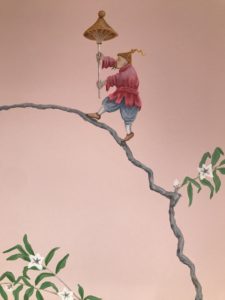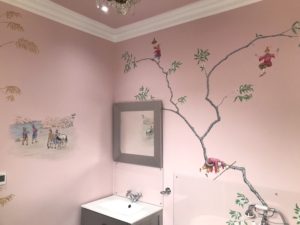12 Aug Brief History of Chinese figurative painting
When most westerners think of Chinese painting, they do not tend to think of figurative painting.
Landscapes of lofty stylized hills or birds and flowers in the spring are familiar and resonate
more readily with similar themes in western art.
Those subjects are more culturally neutral, and easy to visually digest than figure paintings. Most of us need to feel a connection as individuals or representatives of heritage with the people depicted in figurative paintings in order to appreciate them fully.
Having acknowledged the relative unfamiliarity of figure painting to western viewers of Chinese
art and so that we may more fully appreciate this unique genre, let us take a brief look at the
history of Chinese figure painting.
Figure painting in China appeared in the Neolithic era, first on pottery, then on tiles, tomb and
mural cave walls, and in family shrines. Landscape and Bird/flower painting came much later.
Times change, social and historical events became primary reasons for figure painting. Tang
Dynasty court painters such as Yen Li-pen (died in 673), who painted the “Thirteen Emperors”
and Chang Hsian, “Ladies Weaving Newly Prepared Silk,” are represented in the Boston
Museum.

Figure painting lost its momentum with the rise of landscape painting toward the end of the Tang
Dynasty. Academy painters and the literati considered landscape painting the height of
achievement. Li Kung-lin (1040-1106 ) was one of the few scholars who continued Ku Kai-chih’s
tradition.
He was a Confucian gentleman who venerated the past but used his heritage to meet
the popular demands of his time. He was known for his paintings of horses and humans
portrayed with dignity and spirit.
Li created the Pai Miao style (pure line drawing) for figures. His technique has been widely favored by artists since. It uses fine lines and no shadows, merging almost indistinguishably with calligraphy,
A revival of traditional figure painting after decades of decline developed during the Ming
Dynasty.
Chou Chen (c1500-1535 ), Chang Lu (c1490-1563), and Tang Yin (1470-1523)were
scholar-amateur artists who painted individual scholars/officials or ordinary people instead of
groups of people as described in earlier periods. Literati artists were independent painters. To
respond to the demands of a broader audience, professional artists appeared.
Chiu Ying, a landscape artist (c1495-1552) was also especially skillful at painting beautiful women. In “Spring Morning in Han Palace,” now in the Palace Museum in Taiwan, Chiu depicts dancing, playing,
portrait painting, and other daily activities in the beautiful palace.

His techniques are almost exactly like those of the Tang artists we have mentioned, but faces are thinner, there is more variety and color in draperies, and backgrounds are more elaborate. Chiu had a number of
followers.
In the Ching dynasty (1644-1911) figure painting continued but did not flourish. Literati and court
artists only half-heartedly depicted the human figure. Some followed Chiu Ying’s style to
illustrate novels but portrayed slim, listless women to meet the demand for commercial
portraits. Court painters engaged in painting Emperors journeying to the south. Direction.
After 1949 Socialist realism was promoted and the traditional literati forms were discouraged.
Soldiers, workers, laboring women and children became a new didactic style. This style is still
current, but people on the mainland are now free to choose among many styles.
Currently the China Academy of Fine Arts in Hang Chou has undertaken to build the new Che School of
Literati Figure Painting in order to keep the tradition alive and well. Wu Shan-ming’s portrait of a
lady and Tong Chen-kuo’s “Chess Players” in this exhibit are examples of this trend. This
exhibition shows many styles, delivering many different messages, all serving to keep memories
of human history alive.
Western use of Chinese figurative art.
Already outlined in the academic treatise covering the transitional periods in Chinese art, when
this art reached a Western audience in the 18th century it served a purely decorative purpose.
There was a large market in producing hand painted and wood blocked wallpaper and there
were no constrictions to what was depicted.
Many of the great houses including the Brighton Pavilion used fine decorative art depicting
chinese figures going about their everyday business.
Subsequently when it came to mural artists being commissioned to paint chinoiserie in
contemporary times there is a wealth of source material which can be mixed to create an
individual original mural catered for that particular client.
The mural can contain scenic content mixed with figures telling a story, a fishing scene or
horses with their grooms surrounded by mountains, alternatively those figures in the mural can
be interacting with the natural elements to a comedic effect.
For the contemporary western muralist chinoiserie offers a wide range of stylized subject matter
which can be interpreted and depicted at whim to create original decorative murals.
An example of a very contemporary chinoiserie figurative mural painted in recent months by
mural artist Richard Bagguley using a few figures in comedic poses as well as a group including
fishermen and horse grooms.




No Comments